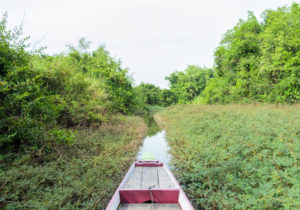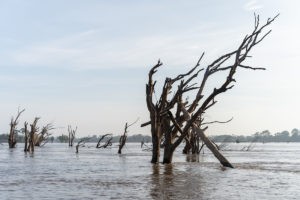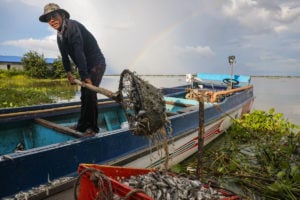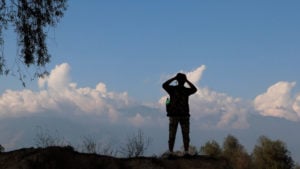The Boeung Prek Lapouv wetlands in Cambodia are not one of the region’s better-known landscapes. Yet it is here, where the Mekong unfurls into its vast delta, that more than a third of the regional population of Sarus cranes gathers each year during the dry season.
Boeung Prek Lapouv is one of the few remaining areas of precious wetland in the upper Mekong delta, where once natural grasslands, marshes and flooded forests seemed to never end. In satellite images, they appear in shades of verdant green and dark blue. On closer inspection, however, as one glides by boat through the channels that skirt the wetlands, one notices dense, thorny stands of plants originally from the other side of the planet: Mimosa pigra, a woody shrub native to the American tropics and widely referred to as ‘giant mimosa’ in Southeast Asia.
This non-native invasive plant is familiar to many Southeast Asian farmers, having cloaked wetlands from Myanmar to Vietnam. Even more common are the thick carpets of water hyacinth, another highly invasive plant from the Americas, that cover much of the region’s lakes and marshes.

An invasive species is a plant or animal that is reproducing in the wild in an area where it is not native, having been introduced as a result of human activity, and which has a negative impact on native species and ecosystems.
Not all introduced species become invasive, but invasive species can be a major driver of habitat change, biodiversity loss and species extinction.
Invasive plants threaten the Mekong’s biodiversity
The Mekong’s freshwater and terrestrial ecosystems span a vast transnational basin at the heart of the Indo-Burma biodiversity hotspot. The wetlands of the Mekong floodplains are known to support some of the greatest congregations of large waterbirds in Southeast Asia. Much of these once-biodiverse Mekong floodplains is now cultivated, and the few remaining areas of natural wetland and seasonally flooded grassland are under threat from encroachment, grazing and fires to clear land for agriculture.
A major, and perhaps far subtler, driver of ecological change is non-native invasive species. The resilience of remaining areas of floodplain wetlands is constantly tested by invasive aquatic plants, such as water hyacinth and giant mimosa. Dryer areas have been invaded by the fast-spreading river tamarind, a species native to Central America that is often planted as a quick reforestation fix and to provide fodder for animals.
There has been little research on the impacts of invasive plants on wetland ecosystems in Southeast Asia, even though their extent has been well documented at many landscapes, and management and control initiatives are already well in place at several sites.
Did you know…
Globally, invasive species have been identified as one of the top five drivers of biodiversity loss
Plants like giant mimosa and water hyacinth often outcompete native plant assemblages and have the potential to deprive native species, such as the globally threatened Bengal florican, of key areas of remaining habitat, as they alter the environment species have evolved to thrive in. A 2018 study showed that the nesting success of river terns on sandbanks along the Cambodian stretch of the Mekong was lower in areas with high cover of giant mimosa, with chick survival rate decreasing with vegetation height. It is probably safe to assume this problem afflicts other species that use open areas of sandy riparian banks for nesting, such as plovers.
Mimosa pigra is widely thought to have arrived in the Lower Mekong river basin at some point between the 1950s and the 1980s. Today, it covers areas in impenetrable thickets where few other species can grow. The plant spreads quickly because it produces large quantities of seeds that are dispersed by floodwaters during the monsoons, and now covers substantial portions of the Tonle Sap floodplain in Cambodia. In Laos’s well-studied Xe Champhone wetlands, there are similarly large areas covered by water hyacinth and giant mimosa. At one point, over 3,000 hectares of wetlands in Vietnam’s Tram Chim National Park, a site well known for its Sarus crane populations, had been smothered by mimosa.
Mimosa stands can directly threaten the biodiversity of seasonally inundated grasslands and freshwater marshes by outcompeting native shrubs and altering habitat for wildlife. A small number of species may be able to benefit from the habitat created by dense stands but there are also impacts for farming: giant mimosa spreads quickly into paddy areas and is not very palatable to livestock. It also chokes the irrigation systems that supply rice fields.
In one study in Kratie province, eastern Cambodia, farmers reported that they had to spend 11 days per hectare every year clearing stands of giant mimosa from their paddy fields. Farmers often lack the resources needed to address the problem on a long-term basis. Fishers around the Tonle Sap also suffer significant losses in income as a direct result of giant mimosa invasions.
Cost-effective solutions to giant mimosa
As well as being one of the largest areas of seasonally inundated floodplain wetlands in the Cambodian Mekong delta, the Boeung Prek Lapouv Management and Conservation Area is a Sarus crane reserve. The wetland is estimated to support up to 35% of the regional population of Sarus cranes, a threatened species on the brink of extinction in mainland Southeast Asia, and very large congregations of the critically endangered yellow-breasted bunting. When drawing up a management plan in 2013, local people and site managers acknowledged the long-term threat posed by the giant mimosa.
Since 2015, experimental interventions have been carried out by conservation charities NatureLife Cambodia and the Wetlands and Wildfowl Trust, in collaboration with Cambodia’s Ministry of Environment, to find cost-effective ways of controlling the spread of giant mimosa in Boeung Prek Lapouv. The findings, which have not yet been published, show that cutting plant stems and allowing the root systems to ‘drown’ during seasonal flooding results in 92.23% mimosa mortality and limited stem regrowth (7.77%).
The cost of this method is only USD 94 per hectare per year, with comparable results reported elsewhere in the region. Over time, the costs of mimosa control can be expected to drop to as little as USD 10 per hectare as stands of the plants are thinned out, based on our existing data.
These promising findings indicate that cutting and flooding is an affordable way to manage dense stands of giant mimosa. However, given how widely the species has spread, it may be that the priority going forward should be to avert serious invasions in areas of high priority for biodiversity through early detection and monitoring.

More research is needed on how invasive plants such as giant mimosa modify habitats, and how specific measures can mitigate their impacts in ecosystems of the Mekong basin. Large areas of wetland across Southeast Asia have already been overrun by invasive species, yet the investment to manage their spread is relatively modest to date. Controlling invasive plants is becoming ever more important, and requires sustained investment from governments and conservation organisations to nip the problem in the bud whenever and wherever possible.





